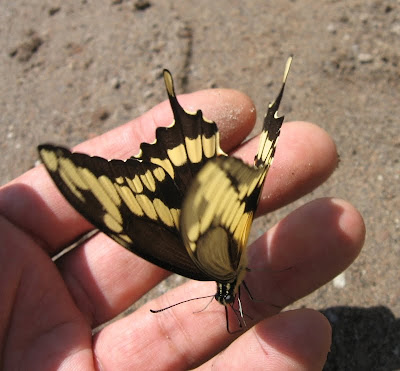Maybe it's the relatively warm winter and spring weather we've had, or perhaps it's due to other factors, but there's a real bumper crop of butterflies this year. In addition to the recent population explosion of Red Admirals there's also an abundance of other species ... Question Marks, Mourning Cloaks, Baltimores, and – relative newcomers to our area – Giant Swallowtails (Papilio cresphontes).
Butterflies can often be seen sipping at mud puddles, bird droppings, rotten fruit or carrion, looking for minerals and amino acids.
They can become so absorbed in their business that they barely notice what's happening around them, and this Giant Swallowtail didn't take flight when I held up it's wing to take a photo of the underside.
The insect shows no fear of me whatsoever as I move my hand closer ...
... and closer ...
I was able to pick this normally skittish and difficult to approach insect up off the sand, and it continued to contentedly imbibe the moisture and perspiration from my fingers.
Butterflies are often attracted to perspiration, and in the past few years I have had many of our local lepidoptera taste test me on warm, sunny days, like the Compton Tortoiseshell back in mid-March. But some butterflies aren't so easily tempted, and I was able to make close contact with this Black Swallowtail (Papilio polyxenes) not because it fell for my charming personality or sweet scent, but because it was stunned due to a misadventure with a passing car.
There were over a dozen Tiger Swallowtails (Papilio glaucus) sharing the beach with the Giant Swallowtails. It seems that their instincts for survival are better honed than those of their larger cousins, because, alas, I was unable to "tame" any of these butterflies ...
A digital capture of the essence of late spring and the beauty of the world around us – a Giant Swallowtail nectaring at Viburnum triloba, more commonly known as Highbush Cranberry.















